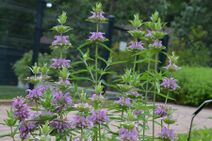Monarda citriodora
| Monarda citriodora | |
 | |
| Light: | |
| Moisture: | |
| Hardiness: | 6 |
| Soil pH: | 5.6-8.4 |
| Self Pollinated | |
| Height: | 2' |
| Blooms: | Mid Summer-Late Summer |
| Native to: | |
| Shelter Nectary | |
| Edible Rating: | |
| Tea: | Yes |
Monarda citriodora (common names: lemon bergamot and lemon beebalm)
Whorled tufts of pink blossoms, speckled with purple, radiate from long spears attract bees, butterflies, and hummingbirds alike. The fragrant edible leaves taste like lemon and can be used in salads, desserts, and teas. The citrus scented leaves contain citronellol and when rubbed on skin makes an effective mosquito and biting-fly repellent. Or the leaves of this drought-tolerant plant can be made into its namesake—a sting-treating balm. This ornamental plant is deer & insect-resistant and grows easily along roadsides and train tracks.
Propagation: Seed - sow mid to late spring in a cold frame. Germination usually takes place within 10 - 40 days at 20°c. When large enough to handle, prick the seedlings out into individual pots and plant them out into their permanent positions in early summer.
The seed can also be sown in situ in late summer in areas where the winters are not too severe and will produce larger plants.
Cuttings of soft basal shoots in spring. Harvest the shoots with plenty of underground stem when they are about 8 - 10cm above the ground. Pot them up into individual pots and keep them in light shade in a cold frame or greenhouse until they are rooting well. Plant them out in the summer.
Division in spring or autumn.
Cultivation: An easily grown plant, succeeding in ordinary garden soil so long as it is not too dry[1]. Requires a moist soil and a sunny position[1][2]. Likes some shade. Prefers a sandy rather acidic soil[2].
This species is closely related to M. pectinata[3].
Said to be a perennial in some books and an annual in others, it has acted as an annual with us so far[K].
A good bee plant[2]. Subject to mildew in dry summers[2].
Range: Central and Southern N. America to Mexico.
Habitat: Limestone barrens and slopes[4]. Prairies, savannahs and roadsides in Texas[5].
Edibility: Leaves - raw or cooked. They are used as a flavouring in salads and cooked foods[6][7][8][K] and also as a tea[9]. They have a pleasant lemon flavour[10].
Usage: An essential oil in the leaves contains a phenol and a citral[11]. No more information is given, though the oil is likely to have medicinal activity and perhaps be suitable for perfumery etc[K].
The essential oil citronellal, used as an insect repellent and in perfumery, is obtained from this plant[5].
Pollinators: Bees
Soil: Can grow in light, medium, and heavy soils.
Flower Type: Hermaphrodite
Links
References
- ↑ 1.0 1.1 Chittendon, Fred. RHS Dictionary of Plants. Oxford University Press, 1951.
- ↑ 2.0 2.1 2.2 2.3 Huxley, Anthony. The New Royal Horticultural Society Dictionary of Gardening. MacMillan Press, 1992.
- ↑ Britton, Nathaniel and Addison Brown. An Illustrated Flora of the Northern United States and Canada. Dover Publications, 1970.
- ↑ Lyndon, Merritt. Gray's Manual of Botany. American Book Co, 1950.
- ↑ 5.0 5.1 Diggs, George and Barney Lipscomb. Illustrated Flora of North Central Texas. Botanical Research Institute, 1999.
- ↑ Uphof, Johannes. Dictionary of Economic Plants. Weinheim, 1959.
- ↑ Tanaka, Tyōzaburō. Tanaka's Cyclopaedia of Edible Plants of the World. Keigaku Publishing, 1976.
- ↑ Yanovsky, Elias. Food Plants of the North American Indians Publication 237. US Department of Agriculture.
- ↑ Facciola, Stephen. Cornucopia - A Source Book of Edible Plants. Kampong Publications, 1990.
- ↑ Bown, Deni. Royal Horticultural Society Encyclopaedia of Herbs and Their Uses. Dorling Kindersley, 1995.
- ↑ Grieve, Margaret. A Modern Herbal. Penguin, 1984.